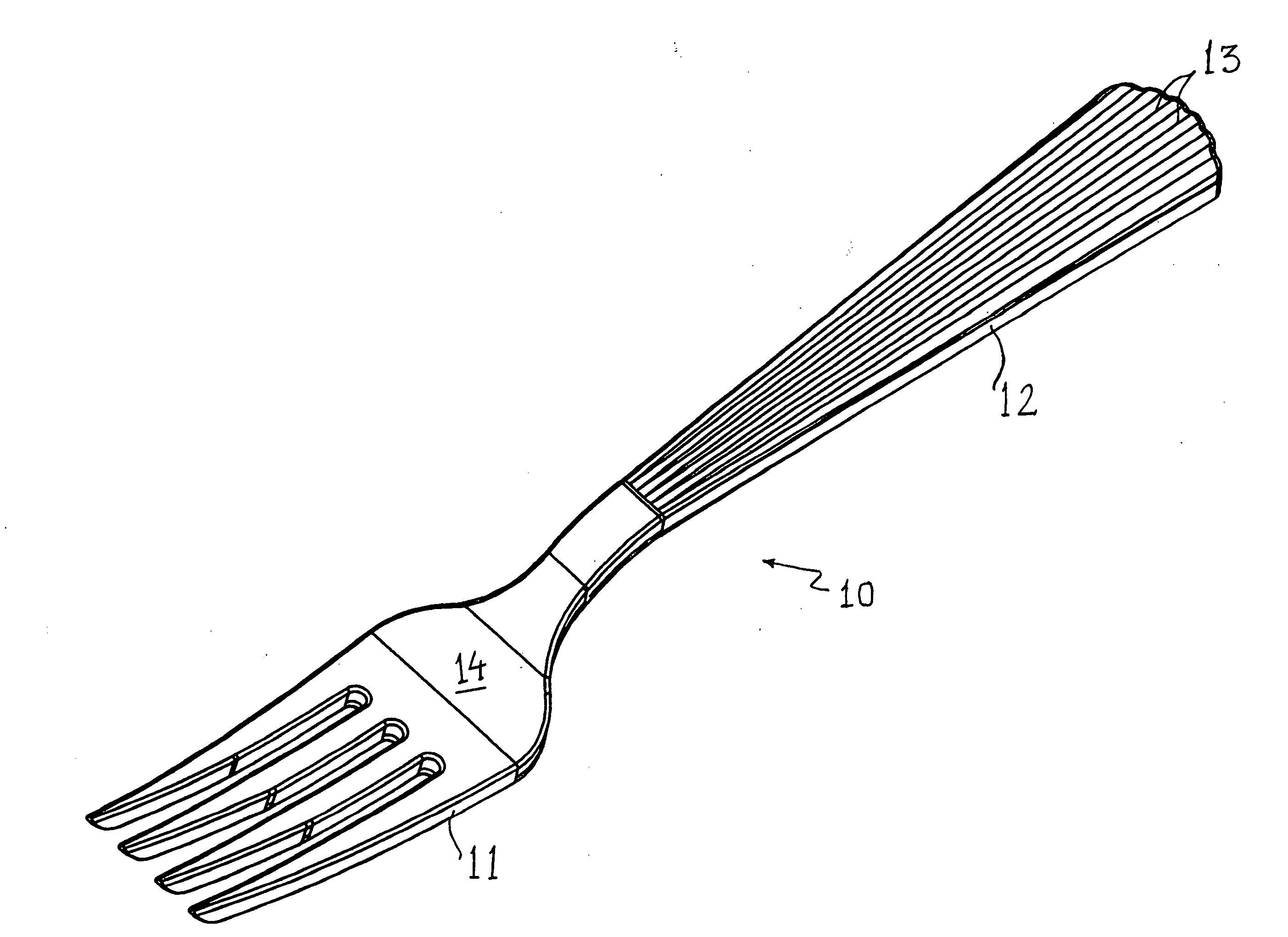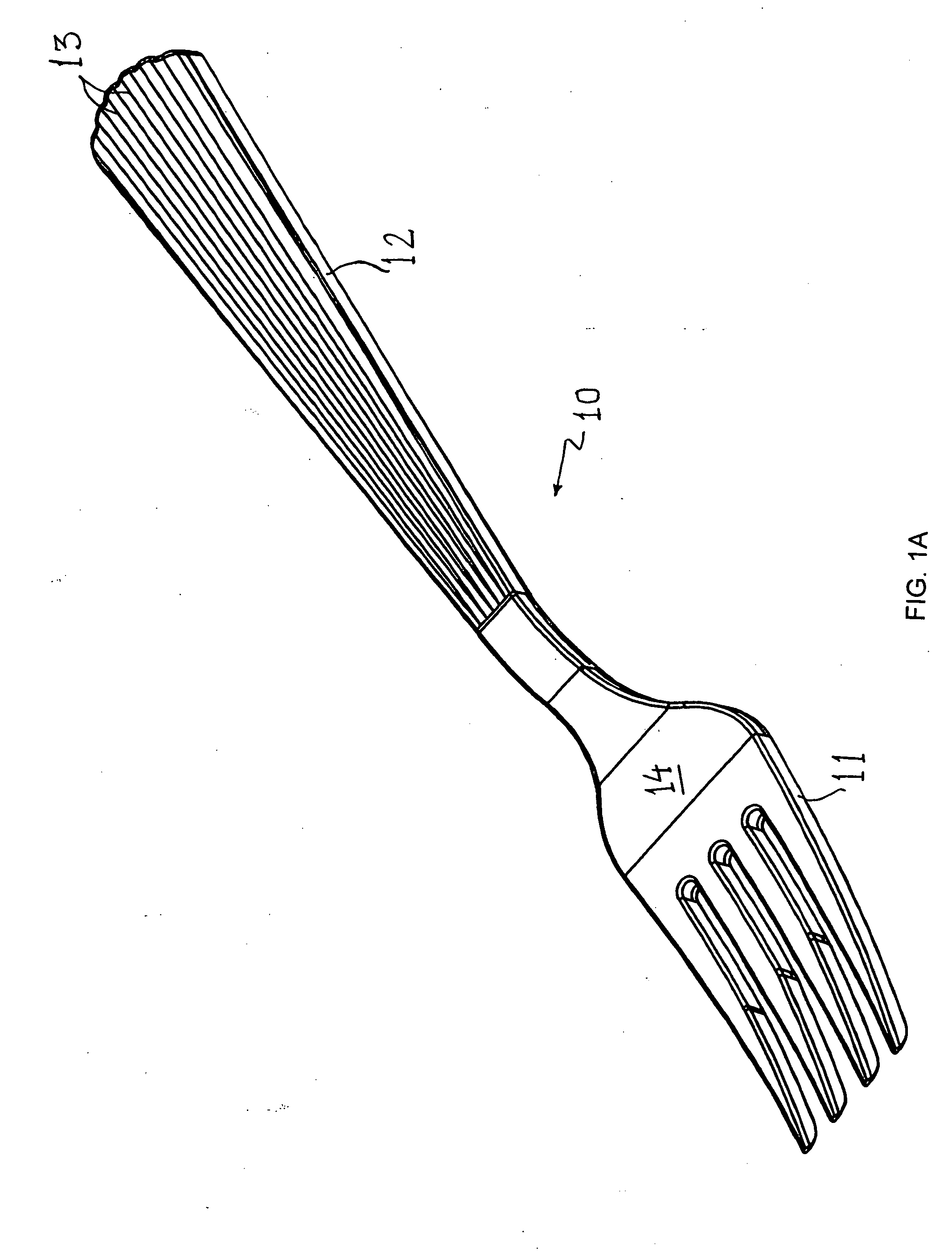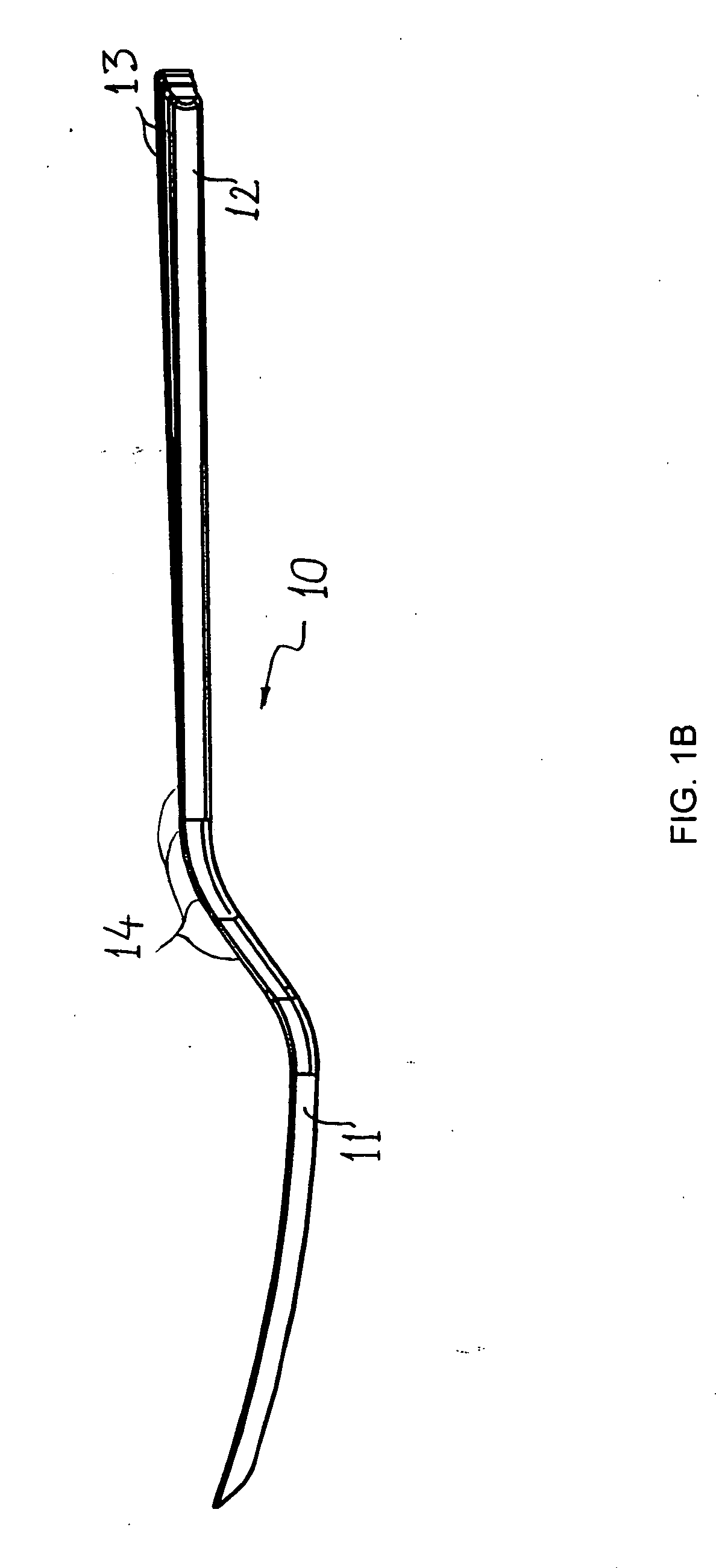In addition, permanent flatware also has to be replaced due to inadvertent disposal or loss.
The presence of non-disposable
metal cutlery along with other disposable food-service articles such as plates, cups and the like presents an unusual problem for restaurants and caterers.
The problem stems from the loss of valuable metal cutlery into trash or refuse-containers along with disposable tableware and food remnants particularly during peak
business hours and rush situations.
As a result, the food establishment has to constantly replace expensive metal flatware.
U.S. Pat. No. 3,926,792, to Buford, filed on Aug. 23, 1973, in Column 1, lines 12 to 30 states:—“The
food industry has long been plagued with the costly and time-consuming problem of separating valuable reusable items, such as metal tableware from
solid waste, such as food, paper and other disposable items.
This problem is prevalent in any food service facility, such as restaurants, cafeterias, schools, prisons, and so on, in which plates must be scraped and / or tableware separated from garbage by hand sorting or by
scavenging, and especially in the airline industry where there is no opportunity for sorting in flight.
Even when manual sorting or
scavenging is carried out, it has been found that a large amount of tableware is lost.
It is obvious that continued replacement of tableware is not only expensive, but economically wasteful.
Some restaurants have found that most missing tableware is lost, rather than taken by customers, and that such losses run as high as $1,300 on a traditionally heavy day.”
U.S. Pat. No. 4,367,138, to Kustas, filed on Jun. 8, 1981, in Column 1, lines 11-16 states:—“ . . . . As is well-known in the restaurant business, the loss of silverware or stainless steel flatware is a very serious problem which costs restaurant owners large sums of money every year.
The problem stems from careless kitchen help and the manner in which food and debris is removed from used dishes.”
Studies made in restaurant kitchens in hotels associated with several intercontinental hotel chains show that not only an occasional item of cutlery is lost in this way, but even the cutlery used by all the guests at a table may be accidentally tipped into the waste container together with waste food, particularly when the restaurant is busy and the waiter rushed.
Another problem that food caterers encounter is the ability to clean metal flatware utensils at certain locations and outdoor catering events.
In preparation for such circumstances caterers tend to carry a large inventory of expensive metal cutlery.
However, the use of disposable plastic cutlery affects the image of the airline, especially in premium seating and higher priced flights.
Thus, a primary obstacle for use of disposable plastic cutlery in upscale situations is the
perception and the image associated with disposable plastic cutlery rather than its performance.
Metallic pigments are known in the art and are commercially available; however, it is the general experience of those skilled in the art that these metallic pigments do not impart an authentic metallic look.
Furthermore, metallic pigments do not provide a plastic cutlery article that emulates the polished silver-like metallic appearance of fine cutlery or silverware.
In fact, almost all commercial plastic tableware or cutlery articles made by utilizing a silver metallic
pigment have a dull or grayish appearance.
In addition, some of the formulations for metallic pigments have an
odor which is less-than-desirable for a food-service item.
The types of inks that can be used with food service articles tend to be limited due to
food contact,
toxicity and environmental issues.
Metallic inks are known in the art; however, metallic inks also have similar
food contact drawbacks and are not adapted for use with
food handling implements due to a variety of reasons.
Firstly, it would be difficult to
handle the three-dimensional shape of a fork or a spoon and to apply a uniform layer of metallic ink thereon in an economic or consistent manner.
Secondly, metallic inks do not provide the characteristic reflective appearance of a polished stainless steel flatware item or similar metallic article.
Thirdly, the appearance of metallic inks would be further marred by the necessity of adding a protective overcoat for safety and
food contact purposes.
Although, it is conceivable that a metallic
label can be devised for use in injection molding, in-mold labeling is mostly limited for parts that either have a planar surface or a smooth curved surface such as the outer wall of a cup.
In-mold labeling is not readily or economically adaptable for articles having complex three dimensional shapes such as typical spoons or forks.
In addition to general shape constraints, in-mold labeling operation on a cutlery article would further prove to be quite challenging due to the presence of ornate features or fine and intricate patterns frequently incorporated on the surface of a plastic cutlery article for commercial acceptance and in consistency with traditional flatware design trends.
It would be readily recognized by those of ordinary skill that the presence of any delicate design features on the surface of the article would interfere with in-mold
label adhesion, which in turn would lead to wrinkling of the
label on the part surface and detract from the overall appearance of the cutlery article.
Once again these techniques are not suited for articles having complex three-dimensional geometry such as cutlery articles.
Foil wrinkling and / or inconsistent adhesion in the intricate detail areas of a cutlery article limit the utility of the
foil stamping process for obtaining disposable cutlery having the appearance of permanent flatware or authentic silverware.
In addition, not all plastics can be readily electroplated.
Furthermore,
electroplating offers several challenges in terms of handling and
processing cutlery articles economically.
This method of obtaining a metallic-look food service items by laminating a metallized film is not readily applicable to cutlery due to the fact that most plastic cutlery is generally produced by the injection-molding process wherein the feedstock is
thermoplastic resin
pellets and not laminated film.
This method is generally too cumbersome for application to plastic cutlery as most plastic cutlery is either made of
polystyrene and / or
polypropylene which are
thermoplastic polymeric materials and do not easily lend themselves to the teachings of the referenced art.
In addition, the typical process for producing cutlery is injection molding and it is difficult and cost-prohibitive to rotate a heavy injection mold.
And, finally the secondary step of cleaning and buffing the plastic piece is expensive and may be unacceptable for food-
service use.
These processes are relatively unattractive for metallizing cutlery because of the high
processing and environmental costs.
 Login to View More
Login to View More 


